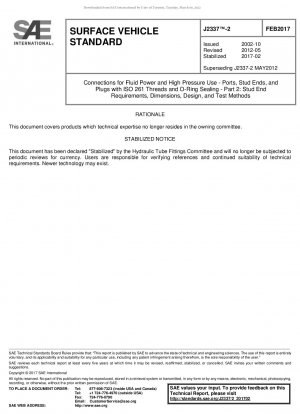SAE J2337-2-2017
Connections for Fluid Power and High Pressure Use - Ports@ Stud Ends@ and Plugs with ISO 261 Threads and O-Ring Sealing - Part 2: Stud End Requirements@ Dimensions@ Design@ and Test Methods
- Standard No.
- SAE J2337-2-2017
- Release Date
- 2017
- Published By
- SAE - SAE International
- Latest
- SAE J2337-2-2017
- Scope
- Purpose This part of SAE J2337 specifies dimensions@ design@ and performance requirements for eight connectors using a conical seal to insure leak proof performance with a design factor of 4 to 1 Field of Application These connectors are intended for general and hydraulic systems on industrial equipment and commercial products@ where elastomeric seals are acceptable to overcome leakage and variations in assembly procedures. These connectors are capable of providing leak proof full flow connections in hydraulic systems operating from 95 kPa vacuum to the working pressures shown in Table 1. Since many factors influence the pressure at which hydraulic systems do or do not perform satisfactorily@ these values should not be construed as guaranteed minimums. For any application@ it is recommended that sufficient testing be conducted and reviewed by both the user and manufacturer to ensure that the required performance levels are met
SAE J2337-2-2017 history
- 2017 SAE J2337-2-2017 Connections for Fluid Power and High Pressure Use - Ports@ Stud Ends@ and Plugs with ISO 261 Threads and O-Ring Sealing - Part 2: Stud End Requirements@ Dimensions@ Design@ and Test Methods
- 2012 SAE J2337-2-2012 Connections for Fluid Power and High Pressure Use - Ports, Stud Ends, and Plugs with ISO 261 Threads and O-Rings Sealing Part 2: Stud End Requirements, Dimensions, Design and Test Methods
- 2002 SAE J2337-2-2002 Connections for Fluid Power and High Pressure Use Ports, Stud Ends, and Plugs with ISO 261 Threads and O-Ring SealingPart 2: Stud End Requirements, Dimensions, Design, and Test Methods
